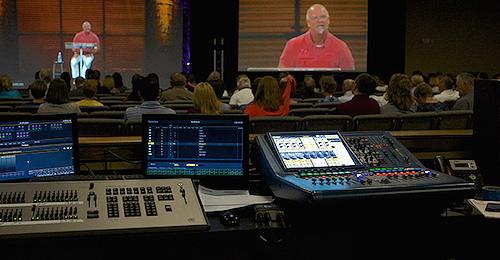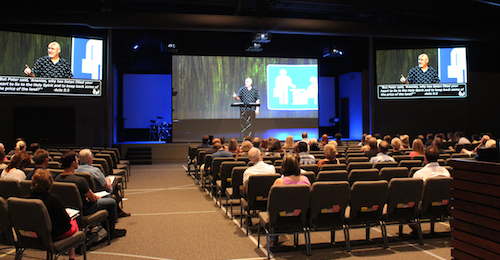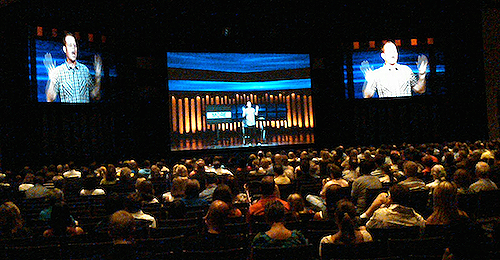Type 3—Independent Satellite Campus Video Venue
Satellite campuses can take on many forms—from temporary facilities like school gymnasiums or fine art centers to new campuses. Aside from the logistics of set-up and tear-down between temporary venues and new permanent venues, the technology is often utilized much like a Video Cafe, only without the shared facilities.
A quick side-bar: One of the least touted but best reasons for adding satellite campuses is local community involvement. Many folks will drive 30 minutes or more to attend a weekend service. However, when a weekday event or service happens, the church will only see a fraction of those people face rush-hour traffic to and from the church in order to get plugged in outside of a weekend service. However, when a local campus from the same church plops down within 15-25 minutes of their homes, nonweekend attendance and involvement soars.
Having visited a large number of church satellite campuses, I’m convinced that the ultimate (and, unsurprisingly, most expensive) format includes a multiscreen, multisource approach. In this setup, two (or more, as the venue needs demand) side screens provide the IMAG feed.
Defining IMAG: The use of close-up and medium (*mid-leg to waist-up) camera shots used to visually engage those seated far from the platform. In video venues, close IMAG camera shots are used on the side screens, while a larger center screen shows a locked-down (*doesn’t move to follow any action) shot of the main stage area, covering an area slightly taller than the main teaching pastor, often without panning the camera to follow. The end effect is a life-sized person on this center screen ‘walking around’ on the stage while the side screens capture the up-close IMAG.
It was North Point church in the Atlanta area that started out using High Definition video for their lock-down camera projected onto a center screen (borrowing an HD camera from NASA, no less). Since that time, many churches have implemented HD video and had stunning success with what I call the “suspension of disbelief.” What happens is that two sources—one recorded from the main campus IMAG switcher and one recorded directly from the center locked-down camera—are routed to the screens. The IMAG feed goes to the side screens and the center camera video is sent exclusively to the center screen (which drops down after the music is concluded). They are synchronized with Time Code, and play back in perfect sync.
Example of a center screen dropped to the stage floor, utilizing a locked-down center camera shot from the main auditorium.

Example of a center screen with a ‘larger-than-life’ teaching pastor sitting on a stool.

Notice how people on the left side look across to the right screen (which is squared to them) and how even the people in the middle largely watch the close-up side screens.

Example of a very large center screen with a projected pastor (about 8 1/2 feet tall on the screen) that provides the suspension of disbelief for the viewer.
The end result: The audience watches the tight shots (IMAG) on the side screens (non-HD) while they see the main speaker/teacher in their peripheral vision. Because people see a “life-sized” version of the person on the stage (in HD), they quickly forget that it’s not real for two important reasons:
1) The HD image quality is far superior to standard NTSC video, resulting in a more life-like version on the center screen.
2) The physical spacing between the side screens and the center screen allow your mind to believe that the center screen is the ‘real thing,’ especially if it’s either hung low enough to be near/at the stage or it’s an ascender screen that comes up out of the stage (see the four photos above).
Type 4—Interactive Satellite Campus Video Venue
The most difficult of the four types of video venues, by far, is the interactive satellite campus video venues. The technology required to connect—in real-time—campuses spread out by miles is not inexpensive or easy to manage. But, for the church willing to make this leap, the results can be amazing.
The trick here is to have a live audio and video backbone (over IP, Microwave or Satellite), and enough channels of audio, video and communications (such as Clear Com), as well as the necessary bandwidth to do it all in real-time. It’s usually done over dark fibre, with direct connections made through a dark fibre backbone (point-to-point or point-to-multipoint) so that bandwidth is never an issue. It’s very expensive (think hundreds of dollars per mile, per month).
Often, though, because video is bandwidth-intensive, some systems integrators will compress the video to reduce the file size during transfer. However, remember that the whole point of that center screen was to make it life-like (hence, the use of HD video). So, if the HD signal needs to be compressed to make it fit over a connection, the end result can be less-than-HD video quality, which negates the point of HD in the first place.
Other than that, just the sheer logistics, staff and volunteers necessary to pull this off is staggering. I know of one church in Florida doing this, going so far as to share the mix between three campuses in real-time, such that the FOH engineer at each campus can pull in the vocals/instruments from any of the other campuses for their own mix. This requires incredible planning and logistics to pull off, and I’m not personally sure this is something I’d ever want to do. But … it can be done.
Conclusions
First, I give kudos to my friend’s pastor Larry Osborne and tech director Dennis Choy of North Coast Church for thinking radically about using video technology—over 20 years ago!—to increase their effectiveness and outreach. They have truly paved the way, and Dennis and Larry continue to make changes as they’ve increased their number of venues.
Second, this is not something to be entered into lightly. While there are quite a few churches doing the Video Overflow or Video Cafe thing already, the disconnect created with the audience if it is implemented poorly is a high price to pay—not to mention the stress on staff and volunteers in a set-up-to-fail scenario.
Done correctly, and within the context of your local predicament, video venues are a tremendous tool for churches. 












